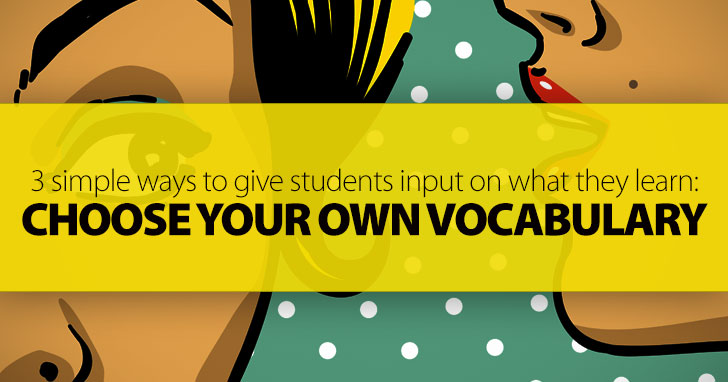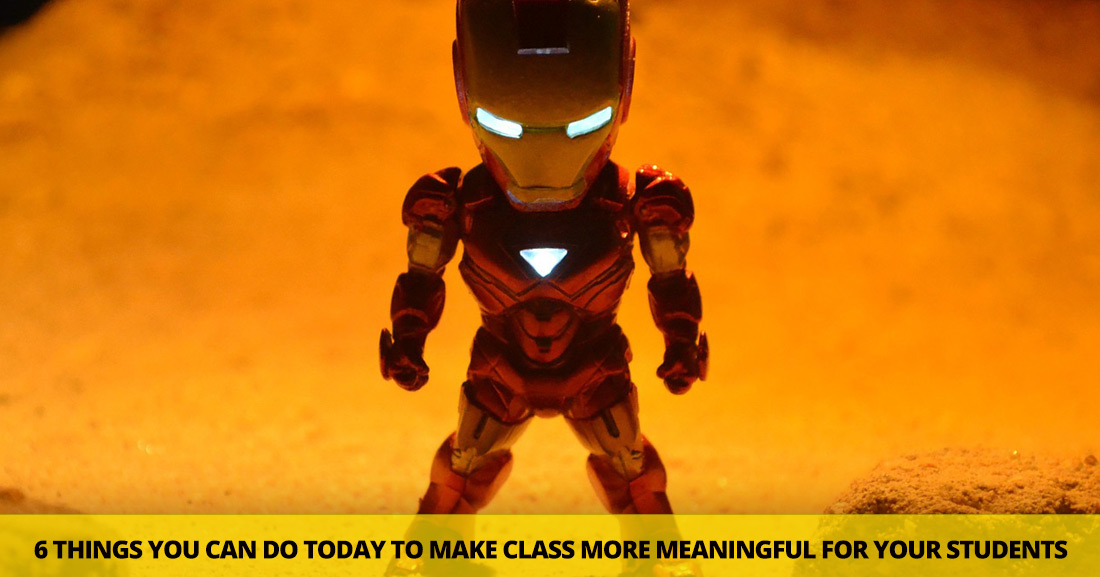Choose Your Own Vocabulary: 3 Simple Ways to Give Students Input on What They Learn


You’re in charge of your class, what subjects you study, and what materials you use. But when students have input in to their own learning, they are more successful. They take ownership in a way that doesn’t happen when they are just passive observers of the materials and content you choose for class. That’s why it’s so beneficial to them and to you when students can have some input into what they learn in class. It’s not hard for you the teacher to make this happen, either. Here are some easy ways you can give your students a voice in what they learn in class.
Something as simple as having a magazine library in your classroom can give your students a chance to contribute to what you do in class. Invite students to bring in English magazines that interest them and put them in a magazine corner in class. Then students can read those magazines during independent reading time, but you can do even more with them. When you are looking for reading material to use in class, an article for reading assignments or on a particular subject, choose something from one of the magazines your students have brought in. They will care more about what they are reading and also feel validated that you see value in what they have contributed to class when you use their materials for your lessons.
Suggestion boxes aren’t just for your local restaurant or shopping center. By setting up a suggestion box in your classroom and explaining to your students how to use it, you will give them a voice in what they are doing in class. You will also get feedback you might not get otherwise. Some students will be afraid to share certain things to your face that the namelessness of a suggestion box will alleviate. You can ask students to write down not only things they might dislike about class but also things they want to study, things they don’t understand, and activities they have enjoyed in class. Make sure if you do set up a suggestion box you check it at least every other day, and be sure students have a chance to put their suggestions in the box when you aren’t looking by positioning it in the back or side of your room rather than up front or on your desk.
You can learn a lot from your students by doing an evaluation with them not of them. This is particularly useful after a special activity or trip. Start by asking students what was good about the activity, and make a list of what they say on the board. Then ask them what was bad about the activity. Make a list of those, too. Finally, invite them to make suggestions of how to do things differently in the future (the ugly). That is the third list you make and the one that will be most useful to you. Not only will this give students input on your activities, it will help you execute that activity better in the future and give your students an easy speaking activity to do in class.
Vocabulary is an area that even the most advanced ESL students can improve in (not to mention native speakers, too). Invite your students to encourage each other to expand their vocabularies by setting up a word wall or vocabulary wall. Invite students to bring in any unfamiliar English words they encounter while speaking to native speakers, while watching television, while reading, or at any other time. Have students write their words each on a separate index card. Then have them look up the definition of each word in English and write it on the back of the card. Finally, students should put each of their words on the designated bulletin board with a push pin. The next time you are putting together you vocabulary unit, supplement your list with words from the wall or even choose all of your words from the wall. Your students will have had a role in what they learn in class and may even have a leg up on the vocab unit if they already learned the words on their own.
You may not have noticed it, but the materials in your text book or curriculum can be off-putting to your students without even meaning to. If you are teaching English overseas and the situations in your text book are all set in the U.S., your students can feel estranged from the material before they even learn what it is teaching them. So try rewriting the material to suite your students and where they are to help them connect more with what they read and listen to. If your textbook dialogue occurs in New York but you are teaching in Korea, change the story so it’s set in Seoul. You will probably be able to leave the rest of the dialogue just the way it is. You can make these types of changes with many of your materials, and that alone can have a surprising impact on your students and how they relate to what they are reading.
One of my favorite ways to start a new unit is with a K/W/L chart. If you aren’t familiar with it, it is a simple graphic organizer that you fill out during a discussion with your class. The chart centers around a topic you intend to teach. Start by having students divide a paper into three columns. Tell them the subject you will be studying. Any content area will work such as sports, food, travel, marine life, having a national language, the Olympics, etc. Have student label the first column with a K. This stands for what they already KNOW about the topic. Spend some time brainstorming with the class on the topic. Write what students say on your board and have the class write those same things in their first column. When the discussion dies down on what they already know, move to the second column labeled with a W. This stands for what students WANT to know. Spend some more time brainstorming, this time listing questions and curiosities. Take notes in the same way as you did before. Save the third column for after the unit is complete. This is another brainstorming session, this time about what they LEARNED about the topic. But before you get to the end of your unit or perhaps even plan the whole thing out, use the questions your students came up with in the second column as you plan what to cover in the unit. Students will notice, whether consciously or subconsciously, that the things they wanted to learn are a part of what you cover in class.
Pay attention to what they think and feel and adjust your plans when you can. If you do, your students will be more eager to learn and will be better overall students. They will also value what they are learning in a deeper way, which will make them learn it better, too.